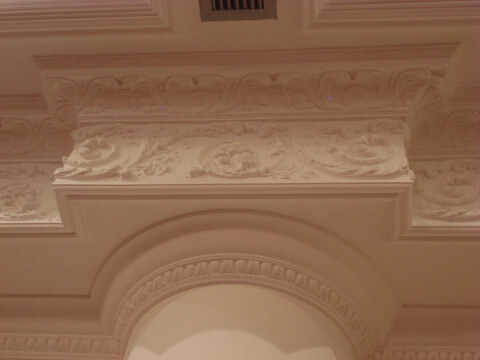
When talking about architecture, especially that of the classical and neoclassical movement, cornices are a term that is often brought up. The word itself comes from the Italian term denoting a “ledge”. In English, the word has come to be used purely in the context of architecture, describing a horizontal moulding that can be found at the top of a building or piece of furniture.
How do internal and external cornices differ?
In the context of buildings, when we talk about cornices we mean either the ledge near the top of the building exterior that is usually decorative in some way, or the interior plaster mouldings decorating the walls just below the ceilings in many homes. While the external cornice can serve an important practical purpose as it protects the walls from excessive rain water, interior cornices have a purely aesthetic purpose.
A brief history of cornices
Cornices have been present in our interiors for centuries. They have been decorating walls and pillars ever since the Georgian period. While they started off as pretty simple, they later evolved into various directions. During the Regency period, cornices became more ornamented, while the Victoria period saw a return to older styles like Gothic and Neo-Baroque. The Edwardian period, on the other hand, came back to a more simple approach, utilising minimal ornamentation and clean lines.
Historically, external cornices served an incredibly important purpose by diverting rainwater from the walls. Nowadays, considering architects employ gutters and other, more effective means of doing that, such as eaves and gutters, their purpose is purely aesthetic, much like that of the interior cornice that comes in a myriad of shapes and styles.
Cornice styles through the ages
Throughout the years, the use of the interior cornice has changed in ways both subtle and profound. At the beginning, from as early as the Georgian period, any rooms in the building that had the purpose of receiving and entertaining guests had cornices that were much more decorative and robust, while those used in private chambers were more bare-bones. These designs were heavily inspired by the Classical period, as well as the English Baroque. The most popular design from that period was the egg and dart – a simple design that nonetheless adds an air of sophistication to any interior. The Georgian period also gave us simpler cornices with sheer horizontal lines – a pattern that is universal and ubiquitous, perfectly complimenting even contemporary homes. The Regency period introduced cornices with more intricate designs, such as leaf patterns, while the Victorian era added a whole plethora of diverse designs inspired by the Gothic and other periods that can still be used to great effect today.
Fibrous plaster and you – implementing cornices into your home in the most practical way
Many people still value the aesthetic qualities of cornices and want to have them implemented into their homes. This is, of course, a perfectly valid choice, and we now have the means of creating the most reliable cornices in history. With fibrous plaster, creating strong, eye-catching cornices is easier than ever. It is still only easy by architectural standards, meaning you’ll get your cornice done quickly and professionally – but only if you trust professionals to do it. Do not attempt to install a fibrous plaster cornice in your home by yourself, as it requires years of professional experience to be applied well.
